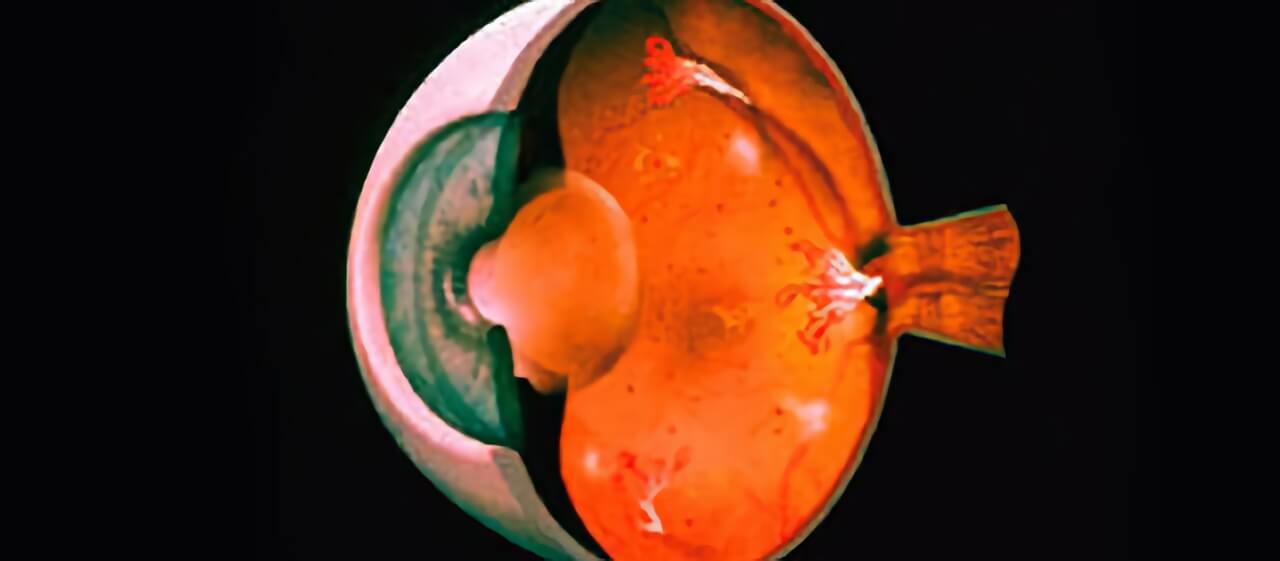Panretinal Photocoagulation
Panretinal photocoagulation (PRP) is an extensive laser treatment applied to the peripheral retina inside of your eye. This treatment is recommended when abnormal blood vessels are growing inside of your eye. If left untreated, these abnormal blood vessels can cause severe and sometimes permanent vision loss or even blindness. PRP reduces the long term risk of vision loss or blindness due to abnormal blood vessel growth inside of the eye but does not completely eliminate the risk of vision loss. PRP has been around for decades as a treatment for abnormal blood vessel growth in the eye and has a proven track record of effectively and safely reducing the risk of severe vision loss and blindness in people who suffer from complications of diabetic retinopathy and retinal vein occlusion.
The procedure is performed by your retina specialist who is a specially trained medical doctor (M.D.) who has extensive training in the diagnosis and treatment of retinal disease. It is performed in the office and there is no special preparation like fasting necessary before treatment is administered.
Download our PDF about Panretinal Photocoagulation

PRP is administered in a special treatment room. Your eye will be numbed with a topical eye drop which may burn slightly and briefly upon instillation. Sometimes, your doctor will recommend an injection of anesthetic under your eyelid and behind your eye in order to minimize any discomfort during the procedure. This anesthetic injection can be initially uncomfortable as it will cause you to feel pressure behind your eye but will last only briefly. You may develop double vision temporarily during and after the injection and your vision may become blurred or even go dark temporarily. This is normal and should not alarm you. You may have a slight “black eye” for several days afterwards. An extremely rare complication of the anesthetic injection around the eye is that it may make you fall asleep, requiring your doctor to maintain your breathing for a short time.
Once your eye has been numbed with either an eye drop or an injection of anesthetic, your doctor will use a very bright light to apply the laser treatment to your retina. This may be done either with you sitting upright with your head placed into a special device or with you lying back in the treatment chair. You doctor may place a special contact lens on the eye to stabilize your eye during treatment or may apply gentle pressure to your eye with a “Q-tip” during treatment. You may experience bright flashes of light in your vision during treatment. You may feel some mild discomfort often described as an “ache” during treatment. If the discomfort is anything more than mild you must let your doctor know immediately.
The treatment will take about 15 minutes. After completion of treatment your doctor may put an eye patch over the eye. You are to keep this patch over your eye overnight and can remove it yourself at home when you wake up the next morning. Your eye may ache for 1 to 2 days and you may take an over-the-counter pain medication like Tylenol or Ibuprofen (Advil) for this. You will likely have blurry vision that may last from one to several days.
Although a safe and effective treatment to reduce risk of severe vision loss from abnormal blood vessel growth in the eye, there are some limitations to treatment, side-effects of treatment, and risks of treatment that are important for you to understand.
PRP will not make your vision better. The treatment simply reduces the risk of severe vision loss from your eye disease. DO NOT EXPECT TO SEE BETTER AFTER TREATMENT. Also, PRP WILL NOT GET RID OF YOUR “FLOATERS” if you have them. Floaters will often naturally become less bothersome to you over time and may take several weeks or months.
Possible side effects of treatment include but are not limited to:
- A temporary mild ache of the eye or area around your eye
- A “black eye” that may last for several days
- Blurred vision that typically lasts for a few days to a week
- Decreased peripheral (or side) vision
- Decreased color vision
- Decreased contrast sensitivity (ability to distinguish sharp lines)
- Temporary light flashes in your vision
- Possible risks of treatment include but are not limited to:
- Loss of some of your vision
- Double vision
- Droopy eyelid
It is important to keep in mind that PRP is not a cure for your eye condition. Controlling your diabetes, high blood pressure, and cholesterol are the most important factors in maintaining the health of your eyes.
You may require multiple laser treatments over your lifetime to control your eye disease. Despite treatment, some people may still loose their vision. The chances of maintaining your vision, however, are greatly improved with treatment.
The effects of laser treatment may take several months to become evident. Your doctor will arrange for follow-up evaluations to monitor your response to laser treatment.
Your doctor at Retinal Consultants is dedicated to keeping your eyes as healthy as possible and is commited to being available to answer all of your questions or concerns about your disease and treatment. Please call our office if you have any concerns about your condition or the treatment that has been advised.


